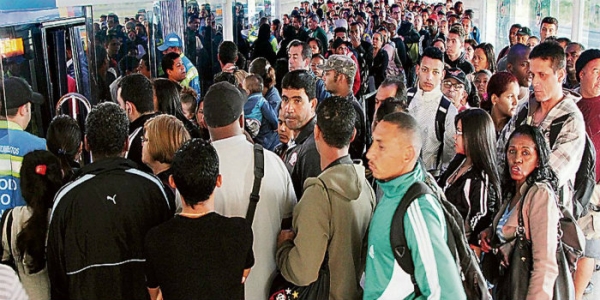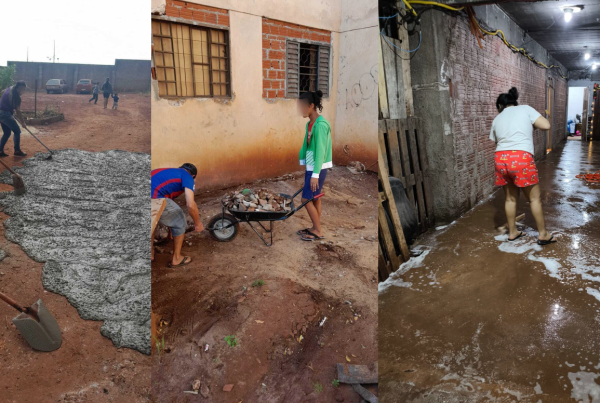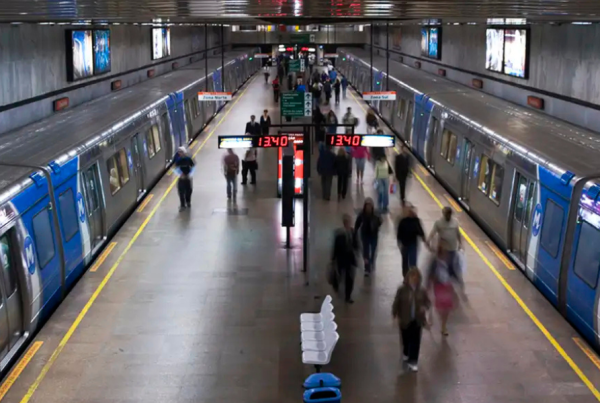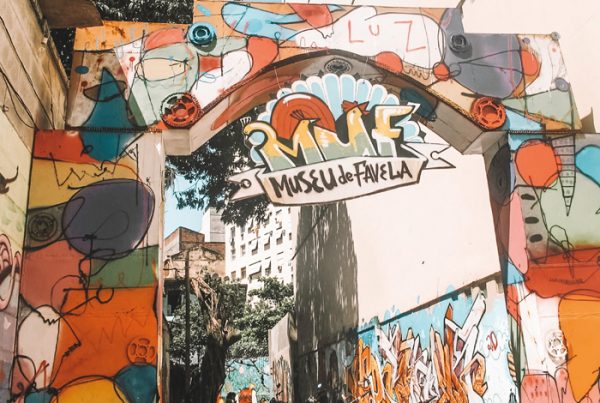In “2016 Olympics and the Impact of the “Transport Revolution” on Socio-Spatial Justice”, researcher Jean Legroux presents the findings of his thesis resulting from an academic collaboration between Université Lyon 2 and IPPUR/UFRJ, an innovative contribution that assesses the impact of transportation projects on socio-spatial justice in Rio de Janeiro from a multi-scale and multi-criteria perspective. The study shows that the impacts of the “transport revolution” brought about changes that do not break with the Brazilian model of road transport or with the logic of segregation of the neoliberal city.
2016 Olympics and the impacts of the “transport revolution” on socio-spatial justice
Will the transport revolution announced by the state government of Rio de Janeiro in the context of preparations for the 2016 Olympic Games reverse the profound mobility crisis affecting its territory? Guided by this question, researcher Jean Legroux has developed in his doctoral thesis an innovative contribution by assessing the impact of transportation projects on socio-spatial justice in Rio de Janeiro from a multi-scale and multi-criteria perspective.
Entitled “Hosting the 2014 World Cup and 2016 Olympics and the impact of the ‘transport revolution’ on socio-spatial justice: change everything so nothing changes?”, the thesis resulted from an academic collaboration between Université Lyon 2 and the Institute for Urban Research and Planning of the Federal University of Rio de Janeiro (IPPUR/UFRJ). In his findings, Legroux showed that the impacts of the “transport revolution” brought about changes that do not break with the Brazilian model of road transport, nor with the logic of segregation of the neoliberal city.
In this light, Legroux stresses that, in Rio de Janeiro, the “attractive city” strategy corresponds to an advanced stage of neoliberalization and commodification of its urban space, based on the triad of mega-events (a celebrated strategy thanks to the 2014 World Cup and 2016 Olympics), favorable economic environment and circumstantial alignment between the three levels of government. According to the researcher, this neoliberal policy of construction and governance of urban space – which implies reconfigured coalitions of traditional actors of the circuit of urban accumulation – is based on the urbanistic requalification of the city of Rio de Janeiro for two purposes: inserting it in the international competition among cities, and, at the national level, halting its trend of economic and political decay, especially noticeable from the 1980s onwards.
In official discourses, the ongoing urban transformations responded to the needs of the “Olympic City” and generated positive impacts for its inhabitants and those of its metropolitan area. In this context, investments in mobility infrastructure were the most important, accounting for 55% of investments for both the 2014 World Cup and the 2016 Olympics.
“In addition to the amount invested, the impacts of the transportation projects are certainly the most significant on the urban space, encouraging public authorities to announce a ‘transport revolution’ capable of solving the urban mobility crisis clearly linked to processes of urban segregation and exclusion. Indeed, this context of building an attractive city enables a historical concentration of investment in public transportation, with a four-corridor BRT ‘structuring network’ (Transoeste, Transcarioca, Transolímpica, Transbrasil) of over 150 kilometers; a VLT (Light Rail Vehicle) line in the port district, which is being completely revitalized by the Porto Maravilha project; the construction of the Linha Quatro metro linking the South Zone (Ipanema) to the Barra da Tijuca area; the renovation and expansion of the rail network; and the construction of three cable-car systems in favelas or favela complexes,” describes Jean Legroux.
According to the researcher, the main projects of the “transport revolution” link the Olympic clusters (Barra da Tijuca, Deodoro, Maracanã and South Zone) with each other, particularly benefiting the areas of Barra de Tijuca and Jacarepaguá, which receive three of the four planned BRT lines and the Linha Quatro metro. “The transport revolution – with the exception of the proposed renewal of the rail system serving the metropolitan area of Rio de Janeiro – is therefore concentrated within the territory of the city of Rio de Janeiro. It is furthermore accompanied by a political-institutional reform of the bus transport system, which involves efforts of physical and fare integration in the public transport system as a whole,” says the researcher.
The thesis shows that, according to official discourses, these changes in public transport in Rio de Janeiro would be able to reverse the urban mobility crisis. In the metropolitan area of Rio de Janeiro, public transport accounts for 71% of motorized trips, against 29% for individual transport, characterizing this mobility crisis as a crisis of public transport, especially bus transport (which accounted for more than 75% of daily trips in the metropolitan area in 2014). “The neglect of the metro and rail systems for decades – alongside the expansion of bus systems (since the 1950s) and the exponential growth of automobile and motorcycle fleets (especially as of 2000s) – are factors that explain the urban mobility crisis in Rio de Janeiro. It should be noted that this mobility crisis affects all social categories (albeit unevenly), to the extent that the increasing congestion affects both bus passengers and private car drivers,” says Legroux.
Thus, will the transport revolution be able to reverse the mobility crisis in Rio de Janeiro? This is the starting point of the thesis that seeks to assess, through a multi-scale analysis (including the metropolitan, municipal and intra-urban dimensions), the various impacts of transportation projects on socio-spatial justice in Rio de Janeiro. In other words, even in the case of positive impacts for the population, will they be evenly shared out among different social groups in the urban space of Rio?
“Choosing the paradigm of justice to understand the different impacts of the ‘transport revolution’ aims to solve conclusively this kind of dilemma: is a transport infrastructure fair if, while enabling 200,000 low-income citizens to improve their mobility, it causes the expropriation of hundreds of poor families resettled in distant peripheries?” provokes Jean Legroux.
One of the first hypotheses of the research is that socio-spatial justice, as a theoretical and analytical tool, is relevant to the study of the processes of exclusion and socio-spatial segregation resulting from mega-events and transport projects. “Indeed, despite the existence of a legacy of urban infrastructure from mega-events, the projects do not equally benefit all inhabitants and give rise to various forms of injustice. The multi-criteria framework of justice aims to identify where, how and why the impacts of the construction of the “attractive city” and the “transport revolution” are unfair or could be less unfair from a socio-spatial point of view,” says the researcher.
Another hypothesis of the study proposes that the impacts and challenges inherent to metropolization processes, in particular to processes of urban space fragmentation – which stem from a model of social organization of the territory strongly marked by residential segregation – are enhanced by the organization of mega-events. This means that the challenge of urban mobility within metropolization processes is also a key factor in organizing a mega-event. Thus, are transport infrastructure projects, in the context of the city, able to meet both the short-term objectives (the actual events, the tourism, business, media and real estate interests of local, national and international economic and financial power, for example) and the dynamics of medium- and long-term urban planning focused the needs of the population?
In that perspective, the all-embracing issue of the thesis is: behind the official discourse and urban marketing, what are the impacts of transportation policies and projects – in the context of the attractive city in Rio de Janeiro – on socio-spatial justice?
Based on various criteria of justice, classified into categories of “ethical qualities,” the multi-criteria analytical framework of justice enables the assessment of: a) the impacts of transportation projects on the fulfillment of demands of capacity and quality; b) the capacity of the “transport revolution” to reverse the mobility crisis; c) the effects on other processes, such as expropriations and real estate speculation. The qualitative methodology (semi-structured interviews and field observation), alongside the multi-criteria framework of justice, enables the identification of the various groups of conflicting actors in the construction of the “attractive city,” and, among them, those who “win” and those who “lose.”
According to Jean Legroux, the findings of the investigation suggest that the impacts of the “transport revolution” in the city of Rio de Janeiro, in the context of the construction of the “attractive city,” bring about changes that that do not break with the Brazilian model of road transport, nor with the logic of segregation of the neoliberal city. “Change everything so nothing changes?” provokes the researcher.
The thesis analyzes the construction of the “attractive city” in Rio de Janeiro in a context of metropolization and international competition among cities, in which they transform their urban spaces by attracting international capital and domestic investment (mainly public). In this sense, the analysis of transportation projects related to real estate dynamics and housing policies is a prime tool to understand the impacts and contradictions of socio-spatial justice in the neoliberal strategy of building an “attractive city.” In addition, transportation projects had direct impacts on the removal of families and low-income communities. The interaction between processes of the “attractive city” and the impact of the “transport revolution” proved to be evident.
“This study was not limited to producing a general diagnosis of the ‘transport revolution’ – that is, the findings on capacity, quality and relevance of each mode of transportation, individually or as a whole – but sought to assess the consequences, general speaking, of a neoliberal model of governance and urban transformation – necessarily contradictory. Indeed, as suggested by Gotham, the context of hosting mega-events usually reveals the underlying tensions of society,” explains Jean Legroux.
Methodology
The methodology of the thesis was based on current geography, in which the spatiality of urban injustices is of paramount important, understanding the city also through the paradigm of socio-spatial justice. Following this logic, the geographical analysis of urban space establishes a dialogue between different ethical concepts of justice arising from different paradigms of political philosophy. “Based on different ethical qualities, opposing various criteria of justice was useful to shift the analysis among the various urban scales, including at the same time the conflictual dimension of urban transformations. Applying the methodology allowed the identification of urban alliances, the conflict of several interests at stake, and the definition of winners and losers,” explains Legroux.
The study shows, for example, the existence of a “dominant” urban alliance composed of local governments (and the federal government), public transport concessionaires, marketing and advertising companies, official sponsors of competitions, and large construction and real estate development corporations. This urban alliance simultaneously serves the interests of the middle and high classes, local elites, the economic and financial sectors involved in this large-scale urban transformation, and of the so-called world class (foreign investors, tourists, athletes, etc.).
On the other hand, low-income populations, most slum dwellers and communities living in precarious conditions were excluded from the benefits of the construction of the “attractive city” and the “transport revolution”:
“The interviews with inhabitants of favelas in this research correspond to the analysis of various urban areas and communities directly or indirectly affected by the attractive city. Without reducing the understanding of the inhabitants of favelas as a homogeneous group in terms of interest, desires and material conditions, the identification of coalitions of interests allowed the identification of major trends, with constant attention to the description and distinction of the various cases studies and/or interviewed actors. The same goes for other affinity groups used in this study. This type of classification into two major groups obviously presents internal nuances, oppositions and conflicts, but it enables the outline of trends and the formulation of certain generalizations,” argues the researcher.
Removals
From the perspective of low-income communities, some general conclusions are pointed out in the thesis: most communities evicted in the context of mega-events had no right to dialogue with the public authorities. A large majority of those removed was relocated (especially by the Minha Casa Minha Vida housing program – MCMV) or forced to resettle in distant outskirts of the city; a substantial number of those evicted and/or threatened with eviction conveyed a sense of injustice and social exclusion.
In the alliance formed by governments, the private sector and urban elites, in turn, Jean Legroux observed a tendency to minimize the impacts of transportation and urban renewal projects regarding removals. “Most of the discourses of this group address the positive impacts announced and rarely considers any unfair aspect (according to various criteria of justice) in ongoing processes for low-income populations. A third group of interviewees, teachers, researchers and members of associations, contributed essential elements to the analysis.”
Conclusions
According to Jean Legroux, the theoretical framework built around the notion of justice enabled a dialogue between the different theories of justice (stemming from political philosophy), applied to the analysis of urban space in geography. This dialogue was superposed onto the empirical analysis, i.e., the discourses and opinions on the impacts of the “transport revolution.”
“The ethical quality of ‘property/efficiency’, which represents the reasoning of justice in terms of efficiency and utilitarianism, was essential to understand the logic of an alliance with decision-making power and interest in urban transformations. Regarding the BRT network, the economic argument was widely used in terms of rational choice (cost efficiency, for example), given the financing limitations to expanding the metro and train networks. Utilitarian logic is concerned with the efficiency, breadth and image of investments, rather than the distribution of benefits arising from them,” states the researcher.
On the other hand, the ethical quality of “equity” was divided into four criteria of justice. The first two criteria are “territorial equity” (which translates into a principle of accessibility, by which all individuals should have access to the same urban amenities, for example), and “horizontal equity” (where urban infrastructure is fair when it does not benefit some individuals more than others).
“These two criteria focus the attention on factors related to the geographical location of low-income residents and the concentration and structural deficit of public transport infrastructure, enabling the conclusion that there is no form of equal access to public (and private) transportation in Rio de Janeiro. In addition, universal accessibility is hindered by successive increases in transportation fares. The ‘transport revolution’ has not been concerned with equal access or use of different means of transportation – which would correspond to meeting the criterion of horizontal equity,” analyzes Legroux.
The third principle in the thesis is vertical equity, which corresponds to Rawl’s maximin principle and led to the conclusion that the “transport revolution” and the attractive city in general are not fair if we consider that less privileged individuals should have received the maximum possible benefits. According to this criterion of equity, the most vulnerable populations should have received more than others, because it would have represented a reduction of an unfair difference (the fact of belonging to a low-income class, for example).
“If the compensation were higher than the loss, we might consider that an expropriation is not necessarily unfair in itself. In the urban sites studied in Rio de Janeiro, the removals are unfair according to the criterion of vertical equity, for the following reasons: 1) the populations who were forcibly removed were already in a disadvantaged position in the city’s socio-spatial structure; 2) the compensation neither met the expectations of the residents (in general, with some exceptions) nor corresponded to the reality of the price of land, given the usual situations of no or negligible compensation, violent eviction and resettlement in regions extremely distant to those previously occupied (sometimes 30, 40 or 50 kilometers away),” argues the researcher.
The fourth principle, that of “real” equity (Sen, 2011), which concerns concrete achievements, enabled the comprehension of, for example, the actual practice of a new mode of transportation. BRT Transoeste transports approximately 200,000 people, but under what conditions? The principle of “real” equity led to the conclusion that the BRT network, but also the cable-car systems, does not afford significant positive change in mobility quality – this also applies to the suburban train system.
The “transport revolution:” the preservation of the road model of mobility and of processes of socio-spatial segregation. The thesis also shows that the “transport revolution” is a reversal in terms of financial and territorial scope, investment, and advances in fare integration – for example, in the public transport system of the city of Rio de Janeiro. It does not, however, represent a paradigm shift.
“In effect, the ‘transport revolution’, for being born in a context of neoliberal governance of urban space, enhances the processes of socio-spatial segregation. In other words, it reinforces the action of housing public policies and the private production of homes, thus intensifying the production of overvalued urban areas and the increasingly distant location of residential areas for low-income populations,” explains the researcher.
According to Legroux, in the wake of the political-institutional change of the bus transport model, which brings advances in fare integration (benefiting mostly bus companies rather than users), the “transport revolution” remains at the service of the socio-spatial exclusion of low-income populations and the logic of real estate speculation which follows the installation and consolidation of the middle and upper classes in urban areas of rising prices. The context of urgency generated by the hosting of mega-events, characterized by a relaxation of the legal, economic and financial systems, among others, accelerates the processes of exclusion, with serious impacts on long-term urban development.
Dossier What Is at Stake in these Games? 2016 Olympics and the Commodification of the City of Rio de Janeiro. (download)

Publicado em Produção acadêmica | Última modificação em 04-08-2016 19:27:56

















